“You behave like a man who lacks talent,” Degas once said to Whistler. There has never been much question about Whistler’s behavior, but only recently have writers tried seriously to come to terms with the problem of his talent. Mr. Sutton, in a most valuable and sensitive essay, has at last provided a critical study in the light of new research, much of it his own. It is surely a relief to find only the barest references to the quarrels and lawsuits which punctuated his life, and to be able to concentrate instead on his development as an artist. The story is a little sad, for though he produced many beautiful pictures, it is hard not to feel that he missed greatness not for want of gifts, but because of a failure to make the most of them.
A Bohemian (better still, an American) and strident in his claims to independence, he yet compromised with official timidity in a way that the bourgeois Manet never did. Wit and bad manners, alas, could not save his art from the endemic English disease of good taste, and looking at some of his society portraits one is reminded of Eric Satie’s comment that “M. Ravel has refused the Legion of Honor, but all his music accepts it.” Whistler alone of artists in England was in close touch with continental experiments, and it is tempting to assume that he setled in London rather than Paris because he knew that the art which he produced there would be sufficiently advanced to cause excitement, yet would not be subjected to the forcing-house conditions under which the more revolutionary French painters were compelled to live. Vasari tells us that Donatello went back from Padua to his native Florence because he felt that his art would benefit in an atmosphere of keen criticism: we find Whistler writing to Fantin-Latour that “it is England that welcomes young artists with outstretched arms.” Nothing could be more indicative than this invitation to a desert of cultural mediocrity extended to an artist who, like himself, was a charming but rather timid innovater. Yet this is by no means the whole story. Courbet had admired him as a young man, and Degas’s comment, though scathing, shows in a characteristically backhanded way how highly his greater French colleagues thought of him. Pissarro also was a most unlikely champion to the end. Praise from such sources is impressive, but also baffling, for Whistler’s affinities were not with any of these artists. He adopted many of the technical means opened up by Manet and the Impressionists, but used them to achieve totally different ends: an increasing concentration on elegance, refinement, mystery, and musical harmony. It was therefore entirely natural that many of his closest admirers were to be found among the Symbolists—men like Mallarmé, for instance (one of whose most beautiful lines Mr. Sutton unhappily misquotes). And some of his interiors very closely resemble the work of Vuillard, who may have seen them, while there are other influences on other young French painters.
Mr. Sutton, indeed, refers to the excitement when, in 1891, the French government bought Whistler’s most famous work, the Arrangement in Grey and Black No. 1—The Artist’s Mother, for the Luxembourg, and points out that one of those who were most struck with it was Toulouse-Lautrec. A greater contrast between the two artists can hardly be imagined, though Lautrec too was admired by Degas and both men contributed to the style of Art Nouveau. “You are one of us,” Degas had told him, and Lautrec was indeed by far the most talented of the artists who followed in the tracks of that great master. The story of his career is a paradoxical one: the very type, so it would seem, of the legendary artiste maudit, deformed, drunk, and syphilitic, and a man of the very highest artistic integrity, he yet achieved public recognition quicker than any of the other great independent artists of the second half of the nineteenth century. His posters were immediately recognized as masterpieces, and even his paintings and lithographs met with only little of the venomous abuse which greeted so many of his contemporaries. The heroism and tragedy of his brief crippled life are all too familiar, but can we really say of him, as Mme. Dortu and M. Huisman do, that “like Michelangelo in his Sistine Chapel ceiling, Bach in his Saint Mathew Passion and Racine in his Cantiques Spirituels, he proclaimed that strength emanates from the clear consciousness of weakness”? The total and meaningless absurdity of the comparisons (no wonder that Life has referred to this book as a “splendid study,” but one would like to hear Lautrec’s own comments) points to an uncertainty of values that is present elsewhere in this volume. “Marginal considerations such as awards, financial gain, dimensions, design, and color were alien to the conception of art as the delineation of human existence which was shared by Lautrec and Van Gogh”—the incredible confusions here could be laughed off, were it not for the fact that they occasionally seem to have affected the treatment of the illustrations, at least two of which cut off sections of the pictures reproduced. But in fact the very plentiful illustrations (which include all the graphic work and many engaging photographs) form the most valuable section of the book, for the new documentary material is not of any great importance—and would be much easier to assess had notes been provided. In their understandable concern to counter the sensationalist vies romancées which have sprung up around Lautrec, the present authors have sadly tamed him. His deep interest in Lesbianism is played down, and authors who have tried to find psychological explanations for the relative tranquility he found in the company of prostitutes are held up to ridicule. It is true that everyone who knew Lautrec has described his courage, humor, and gaiety, but it is also important to remember the poignant perceptiveness of his sad comment: “When one says that one doesn’t mind, it means that one does.”
Advertisement
This Issue
December 3, 1964




